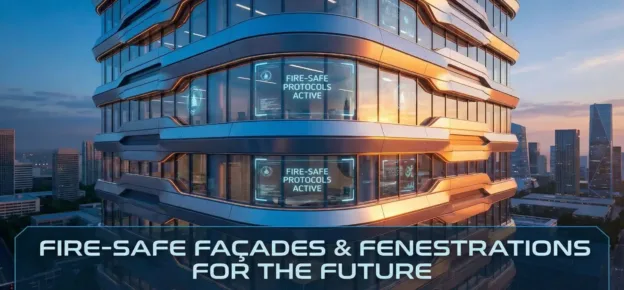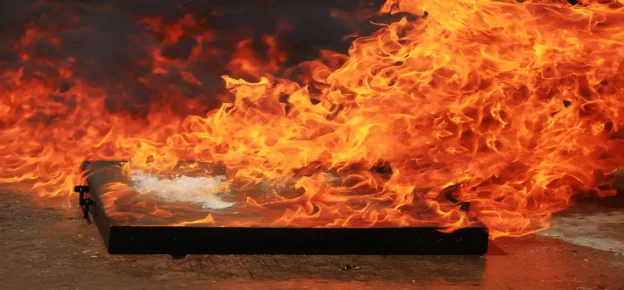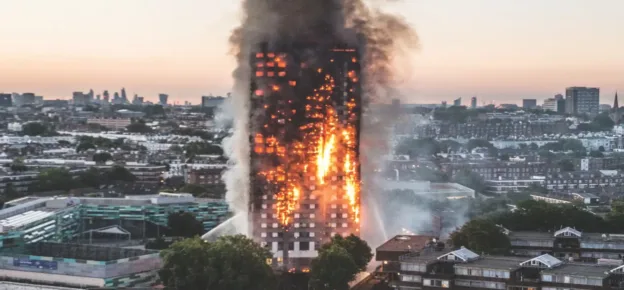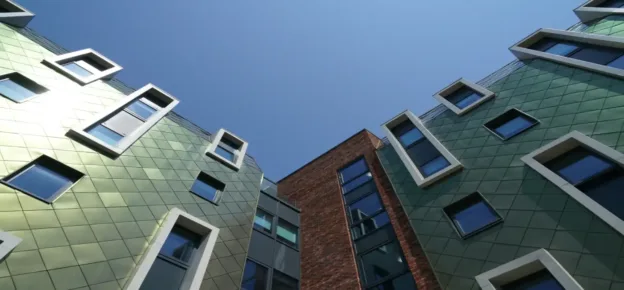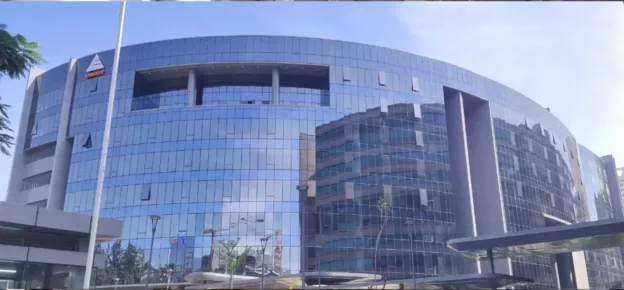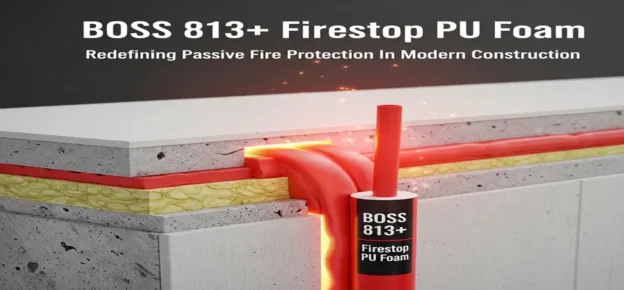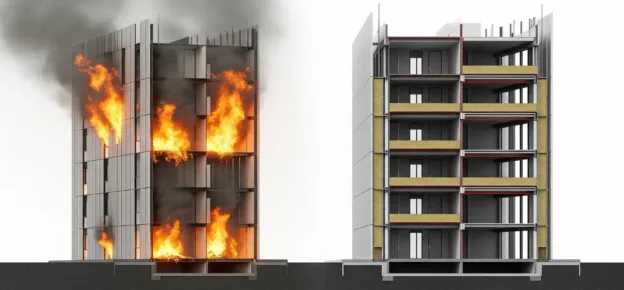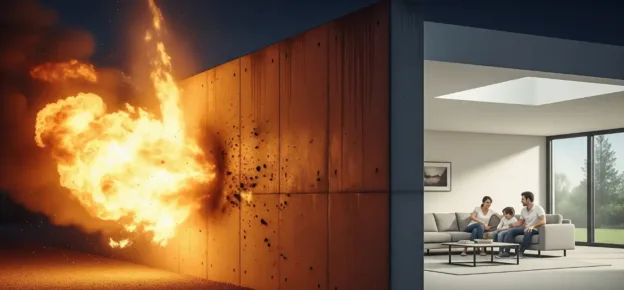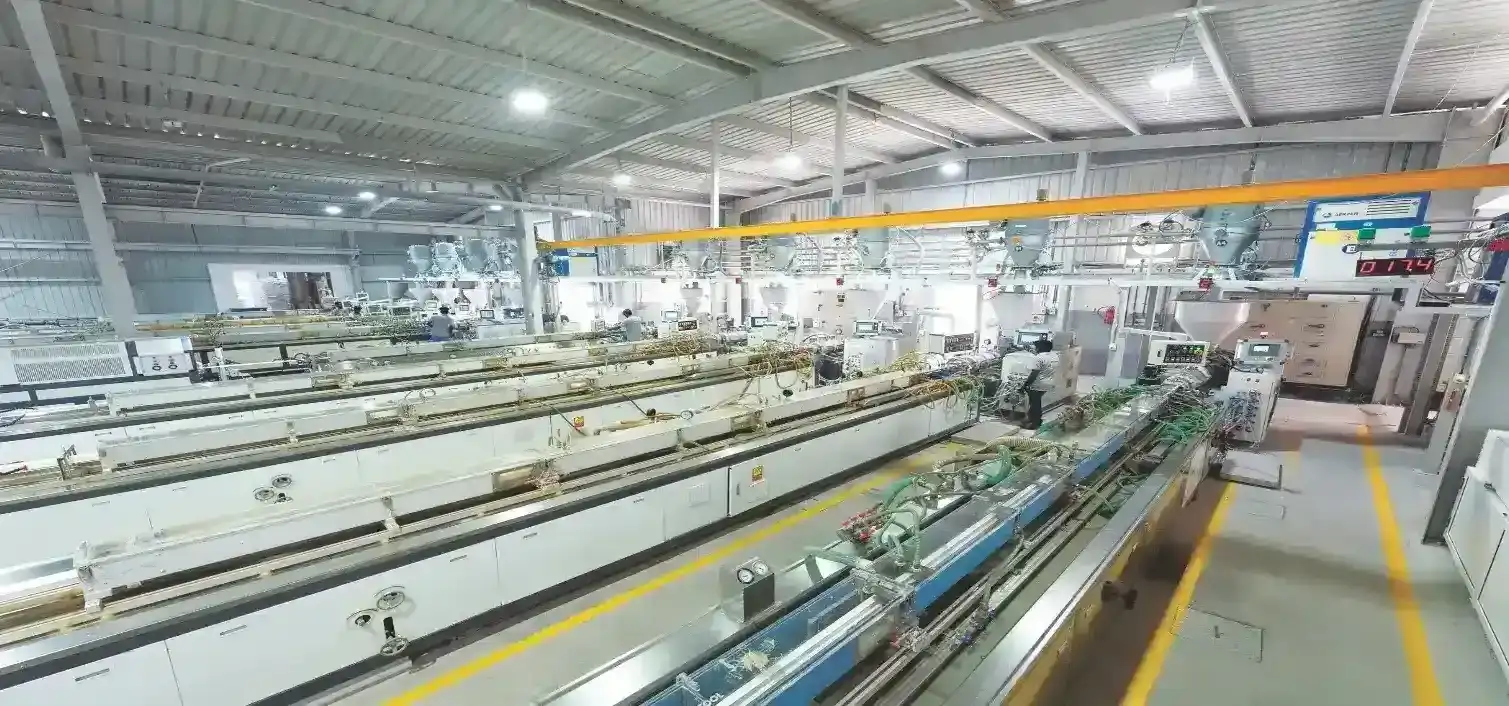In an era of rapid urbanization and vertical growth, fire safety has emerged as a critical concern for the built environment in India. With increasingly complex building designs and material innovations, ensuring compliance with robust fire safety standards is not only essential for safeguarding property but also, more importantly, human life. Against this backdrop, our cover story delves deep into the current status of India’s fire safety norms in comparison with global standards, offering a comprehensive view of the gaps, progress, and potential reforms needed to bring Indian practices at par with international benchmarks.
To explore this vital issue, we interviewed several subject matter experts from across the façade and construction industry. Their insights present a well-rounded perspective on the efficacy of India’s regulatory framework, the challenges faced during implementation, and the proactive steps being taken by leading organisations to enhance fire safety in design, materials, installation, and ongoing maintenance. This cover story also highlights emerging trends, particularly in doors and windows, that align with a more fire-resilient architectural approach.
Beyond regulatory frameworks, our experts also delve into challenges arising from varying fire norms across Indian states, the role of innovation in fire-retardant materials, and the urgent need for technical training and certification in system installation and maintenance. Together, these informed voices reflect a growing industry consensus: India is progressing in the right direction, but stronger enforcement, education, and collaboration are key to ensuring fire-safe buildings for the future.
India’s Fire Safety Norms In Comparison With International Standards


India has made commendable progress in defining fire safety standards, especially with increased awareness around façade safety in recent years. However, when compared to international benchmarks, there is still a noticeable gap – particularly in terms of enforcement, periodic updates, and third-party testing mechanisms. According to Nitin Jain, Managing Director, Viva ACP, countries in Europe, the Middle East, and North America have adopted more stringent protocols that involve full-scale testing, independent certification bodies, and real-time compliance audits. In India, while the intent is strong, the implementation varies from state to state, and standardised adoption is still evolving. There is also a need to move beyond document-based compliance toward performance-based evaluations that assess how a material or system behaves in real fire scenarios. We’re progressing in the right direction, but more work is needed to match the rigour and consistency seen internationally.”

Neeraj Nayyar, National Head of Specifications, Siderise Group, observes that there is a reasonably solid framework in place with the National Building Code (NBC) 2016, but there are still lessons to be learnt from international standards in several areas – particularly around implementation, compliance and enforcement, which remain key challenges. Nevertheless, fire safety norms and standards in India are constantly evolving. “For example, in 2023, the Bureau of Indian Standards (BIS) introduced IS 18190: 2023, which assesses the fire resistance performance of perimeter fire barrier system assemblies. It’s holistic, ‘system approach’ goes beyond both current standards here, and those developed elsewhere in the world, especially with the provision for testing air leakage rates. However, this is yet to be adopted as part of an updated building code”, says Nayyar.

Nikhil Parasuraman, Managing Director of SE Controls India, opines that we can safely say that India’s fire safety norms are evolving and aligning with international standards and with the revision of NBC expected later this year, we can see much more advanced norms coming in for safer buildings, and as the BIS keep revisiting and revising the NBC it will only get more stringent, which is great. “Any standard is only truly followed when enforced and implemented properly with strict penalties for non-compliance. Having mandatory stop checks in between build phases will allow for the norms to be truly well enforced.”

Ranjeet Sharma, President & CEO, 3A Composites India Pvt Ltd, states that though India has made progress in establishing fire safety norms, incidents such as the frequent fire outbreaks in high-rise buildings across major cities like Mumbai reveal gaps in enforcement and compliance. “Globally, fire safety regulations like NFPA 285 and EN 13501-1 are considered benchmarks. To match international standards, Indian regulations must incorporate such globally recognised test methods and ensure stricter compliance”, adds Sharma.

Vishwajit Pandey, Senior Vice President, Winwall India, opines that India has made commendable progress in developing its fire safety framework, particularly through the National Building Code (NBC 2016), IS 1642, IS 3809, IS 18190 and relevant fire and life safety guidelines. However, when benchmarked against global standards such as the NFPA (National Fire Protection Association – USA), BS EN (British & European), or Australia’s NCC, India’s approach still tends to be more prescriptive than performance-based.
Our codes need further refinement to address the rapid evolution of façade materials and complex geometries now prevalent in modern architecture. Moreover, the implementation and enforcement of fire safety norms remain inconsistent across regions. There is an urgent need for centralised, standardized fire performance criteria for façades – especially concerning aspects like vertical fire spread, cavity barriers, and combustibility of cladding systems.

Recommended Amendments For India’s Fire Safety Standards
Jain opines that the future of fire safety in India must be shaped by greater clarity, consistency, and real-world applicability. He emphasises the need for clearer categorisation of façade materials – particularly for products like ACP and HPL – with well-defined testing standards and mandatory third-party certifications. According to him, the establishment of a national fire compliance registry would bring much-needed transparency by listing all approved fire-rated materials along with their test credentials.
He further advocates for performance-based testing protocols that replicate real building conditions instead of relying solely on laboratory-scale results. Training and education, he says, should be a central focus – installers, contractors, and even end-users must understand the importance of selecting and correctly applying fire-safe materials. Additionally, he advises that fostering innovation in non-combustible material technologies – such as mineral core or all-aluminium panel systems – combined with skilled installation practices and consistent regulatory acceptance, will raise fire safety standards across India’s rapidly growing built environment.
ParasuRaman agrees that India’s building codes and fire norms are generally well-structured with strong interlinkages among chapters. However, he observes that shortcomings persist in areas such as enforcement, post-occupancy third-party audits, and the adoption of modern approaches like performance-based design. He recommends the creation of codes that mandate periodic preventive maintenance (PPM) for all relevant systems. As an example, he refers to BS 7346-8:2013, which governs components for smoke control systems, covering planning, design, installation, commissioning, and maintenance. He suggests that enforcement could be undertaken by local authorities or third-party audit firms appointed by the municipality.
Sharma advises that India must integrate internationally recognised test methods like NFPA 285, which evaluates fire propagation in façade systems, and EN 13501-1, which assesses individual product performance. He stresses the importance of mandating certified fire-retardant materials – such as aluminium composite materials (ACMs) with at least a 70% non-combustible core – as a standard. In addition, he recommends that regulations should actively discourage the use of highly flammable materials and promote routine fire safety audits, particularly for public and high-rise buildings.
According to Pandey, to strengthen India’s fire safety regime, several important amendments should be considered. First, there is a pressing need to adopt a performance-based framework. This would require moving beyond prescriptive codes and embracing performance-based testing protocols such as BS 8414 or NFPA 285, which evaluate real-world fire scenarios on full façade assemblies.
Second, fire testing of façade cladding systems must be made mandatory. This includes introducing compulsory large-scale fire testing and requiring third-party or BIS certification for all façade materials and systems. Alongside this, it is essential to provide relevant training to BIS personnel and fire service officers. Such training should focus on the various fire standards (IS) that have been published for fire safety products, ensuring uniform implementation across the country without any dilution.
Third, a national registry and standardisation mechanism should be established. This would involve setting up a centralised body or registry that certifies fire-rated products and maintains up-to-date compliance records. In addition, periodic revisions of codes are necessary. Regular updates to the National Building Code (NBC) and IS codes should be undertaken to reflect global best practices and to address emerging risks posed by new materials and evolving design trends. Finally, there is a need for façade-specific fire safety guidelines. A dedicated chapter within the NBC should be created to address façade design, fire resistance, and installation protocols in detail.
A more harmonised and proactive approach will not only save lives but also enhance the credibility and inspire greater confidence in India’s built environment.

Ensuring Compliance And Performance Of Products/Projects During Fire Events
Nitin Jain, speaking about Viva’s commitment to fire safety, says that fire safety is not an afterthought – it is a fundamental pillar of their design, engineering, and manufacturing processes. He explains, “Our state-of-the-art in-house manufacturing facility, equipped with 14 advanced production lines, has a robust annual capacity of 15 million square metres. Every panel we produce is engineered to meet and exceed global fire safety standards, especially in terms of material composition, reaction to fire, and long-term performance.”
According to him, Viva is the first and only company in India to have an in-house FR Class A2 core manufacturing facility, providing complete control over fire-resistant material formulation and quality assurance. He also emphasises their commitment to local sourcing, with all raw materials procured within India, which promotes self-reliance and ensures tighter supply chain traceability.
Jain adds that Viva offers a comprehensive range of fire-retardant ACP panels, certified as per EN 13501-1 (Class B-s1, d0), a benchmark for low flame spread and minimal smoke emission. He elaborates on their specialised production lines:
- FR Class A2 Production Line, using a 90% mineral and 10% recycled polyethylene core, delivering high fire resistance without compromising on design flexibility.
- FR Class A2+ Production Line (also known as ACCP – Aluminium Core Corrugated Panel), which uses a 100% aluminium honeycomb structure with zero polyethylene content. This makes it a preferred solution for high-risk zones, eliminating the risk of fire propagation from the core itself.
He further opines that their products undergo rigorous in-house testing and are certified by globally recognised institutions like Thomas Bell-Wright International Consultants. Additionally, Viva collaborates with architects, façade consultants, and contractors at early design stages to help specify the appropriate fire-retardant grade tailored to each project.
Nayyar notes that the Siderise has significantly invested in education and industry awareness. “We offer in-person seminars and online learning through our Siderise Academy portal, including webinars and on-demand modules. We also support the work of independent organisations such as the IFC and the Association for Specialist Fire Protection (ASFP),” he says.
ParasuRaman affirms that their products are tested and certified to EN 12101/IS 21927, a European standard covering smoke and heat control systems, including various types of ventilators and components. He adds, “We also conduct rigorous in-house testing to ensure reliability and endurance in emergency situations, with the highest safety standards followed during the manufacturing of our actuators and controls.”
Sharma opines that the use of certified Fire Retardant Aluminium Composite Materials (FR ACMs) is key to achieving effective fire performance. “We prioritise products like ALUCOBOND PLUS and ALUCOBOND A2, which have 70% and 90% non-combustible mineral cores respectively,” he says. These materials, he adds, are tested as per EN 13501-1 and can form part of systems evaluated by NFPA 285, ensuring effective performance in real-world fire scenarios. “Moreover, these materials emit negligible toxic gases and prevent flaming droplets, allowing safe evacuation and reducing risk to life and property,” he concludes.
Pandey notes that fire safety is not a checkbox—it is an integral design and delivery philosophy. He explains that their process begins by testing semi-combustible or fire-retardant materials as per IS and international standards. All products, he adds, undergo thorough third-party testing for flame spread and structural integrity under fire conditions.
According to Pandey, Winwall is also accredited by NABL to conduct full-scale fire mock-up tests in an ISMA chamber (Inter Storey Mock-up Assembly) to validate system performance under realistic conditions. He further states that their engineering team verifies the designs of façade assemblies with compartmentalisation, fire stops, and cavity barriers to prevent the spread of flames through concealed spaces.
Moreover, he highlights that they collaborate closely with fire consultants, architects, and local fire authorities from the conceptual stage to handover – ensuring every façade cladding system fulfils statutory requirements and fire engineering logic.

Challenges In Complying With Diverse Fire Safety Norms Across Indian States
Jain points out that one of the most significant challenges is the fragmentation of fire codes across different states. While some regions have adopted the National Building Code (NBC) in full, others continue to rely on older or custom guidelines, which leads to ambiguity. He further observes that there is a lack of awareness or technical understanding at the execution level, often resulting in the incorrect installation or substitution of materials. To address these issues, Jain says his team maintains a detailed compliance matrix for regional codes, partners with local consultants and authorities to ensure proper documentation and certification, and conducts product briefings and knowledge sessions to bridge the technical gap among decision-makers and on-ground teams.
Highlighting the challenges, Nayyar observes, “Most states have their own fire safety norms, based on local byelaws that are often prioritised over the NBC. This leads to considerable variation across the 28 states.” He points out the inconsistent understanding among stakeholders and fire officers regarding compartmentation requirements. “People know the value of fire safety and the importance of compartmentation, but they do not necessarily understand the nuances of testing and performance for our products,” he says.
He explains further that a Fire No Objection Certificate (NOC) issued by one state may cover different passive fire protection criteria compared to another. Often, there is insufficient detail, with no clear distinction made between a fire or smoke seal and a fire barrier system in a curtain wall, resulting in the compartment zone not achieving the required fire resistance performance.
ParasuRaman opines that there are multiple challenges stemming from the absence of a nationally enforced system, such as the Automatic Smoke Ventilation system on glass façades. He explains that although most states follow NBC Part 4, the enforcement varies significantly. Municipalities in Tier-1 cities with higher population density and more high-rise buildings often have their own fire safety acts that supersede the NBC. According to him, this situation weakens the enforceability of NBC, reducing it to a set of recommendations. He strongly advocates for the enforcement of NBC 2025 across all states to establish a uniform National Fire Safety Act.
Sharma agrees that varying fire safety regulations across states lead to inconsistent expectations in material selection and approvals. He notes that some regions still permit the use of non-fire-retardant materials in cladding systems, which poses a serious safety concern. To overcome this, Sharma says his organisation consistently recommends globally certified materials across all projects. He also stresses the importance of educating stakeholders on the long-term advantages of using tested and certified fire-retardant systems, regardless of the regional discrepancies in fire safety norms.
According to Vishwaji Pandey, one of the most persistent challenges is the lack of uniformity in fire safety interpretation and enforcement across Indian states and urban local bodies. He notes that approvals, required documentation, and permitted materials can vary widely — causing delays and rework despite national codes being in place.
To navigate this, Pandey explains that they maintain a dedicated code compliance team that tracks local by-laws, liaises with authorities, and ensures early alignment of specifications with regional fire norms. This team plays a critical role in adapting to varying regulations and avoiding potential setbacks.
He further adds that the company works closely with local fire consultants and establishes open channels of communication with the respective fire departments during the design stage. This early engagement helps in aligning project plans with local expectations and minimising delays.
Pandey also states that internal knowledge transfer sessions are conducted regularly to ensure that their design, execution, and QA/QC teams remain in sync with state-specific variations. This approach promotes a cohesive understanding across departments and supports consistent compliance.
In addition, he mentions that they maintain a comprehensive compliance library to streamline approvals and documentation across multiple regions. This central repository of codes and guidelines helps in reducing ambiguity and accelerating the approval process.
Pandey concludes by emphasising that proactive engagement and technical preparedness remain their strongest tools to deal with these regulatory disparities.

The Need For Training And Support In Installing And Maintaining Fire-Safe Façade Products
Jain opines that the effectiveness of any fire-rated façade system depends not just on the quality of the product but equally on how it is installed and maintained. “Even the most advanced fire-safe panel can underperform if not handled or fitted correctly,” he warns. At Viva, they have developed a multi-tiered training and support ecosystem to address this issue. This includes on-ground training programmes for fabricators and installers, digital resources like manuals and instructional videos to standardize installation procedures, and workshops or CPD sessions for architects, façade consultants, and project engineers. These focus on material selection, design integration, and code compliance. He further shares that Viva participates in numerous conferences and knowledge-sharing platforms with industry bodies and educational institutions to raise awareness about fire-retardant materials and façade safety. Looking ahead, he advocates for a nationally recognised installer certification programme, potentially led by organisations like BIS or CPWD, to ensure uniformity, accountability, and skill validation throughout the project lifecycle.
Nayyar agrees that effective passive fire protection requires installation strictly in line with manufacturer guidelines to accurately replicate tested systems. He states that Siderise’s dedicated Site Services team supports installers at every stage of the construction process, offering product installation training and conducting benchmark installations. This assistance complements independent industry-led training schemes that provide general best practice guidance for passive fire protection installations. According to him, the Siderise Inspection App further enables installers to self-audit and monitor installations effectively, with compliance ensured through inspection reports reviewed by Siderise Site Service Engineers.
ParasuRaman also emphasises the importance of a holistic approach to fire and life safety systems, stating that any such system must follow a cradle-to-cradle approach. This means that design, implementation, and preventive maintenance should be interconnected. He advises that proper guidance should be given to facilities teams to ensure they take preventive and predictive maintenance (PPM) plans from OEM-authorised partners. He cautions that many systems are installed merely to meet occupancy requirements and are rarely maintained correctly, creating significant fire and life safety liabilities.

Sharma echoes the view that proper installation is critical in ensuring the performance of fire safety systems. He explains that even the best materials can fail if not installed correctly. According to him, technical training for installers and contractors on the handling and fixing of fire-retardant cladding materials is essential. He also advises conducting regular maintenance protocols and awareness workshops to ensure ongoing compliance with fire safety standards.
According to Vishwaji Pandey, installation is where fire-safe intent becomes real-world protection. He emphasises that even the most rigorously tested systems can fail if they are incorrectly installed or poorly maintained.
He notes that India urgently needs structured and certified training programmes for façade contractors, installers, site engineers, and maintenance personnel. These training programmes, he says, should focus on several critical areas. First, they must ensure the correct placement of fire stops, barriers, and sealants. Secondly, there should be proper training for the installation of rated glazing systems and rainscreens. It is also essential to ensure compliance with tested assembly conditions. Finally, long-term inspection and maintenance routines must be incorporated into standard practice.
Pandey highlights that at Winwall, they offer on-site training sessions, detailed installation manuals, and mock installations to ensure that product integrity is upheld throughout the project lifecycle.
He strongly advocates for project specifications to include post-installation inspections and third-party audits, which help certify that systems remain compliant even after handover.
He concludes by stating that fire safety is a shared responsibility, and that empowering all stakeholders through knowledge is key to creating safer buildings.

Conclusion
The discourse around fire safety in India, particularly within the façades and fenestration segment, reflects a crucial turning point – one marked by an evolving regulatory framework, increasing awareness, and the urgency for implementation that aligns with global standards. While India has undoubtedly made significant headway in defining fire safety norms, the collective insight of industry leaders highlights that much remains to be done – especially in achieving consistency, enforcement, and nationwide standardisation.
From the observations of Nitin Jain to the insights shared by Neeraj Nayyar, Nikhil ParasuRaman, and Ranjeet Sharma, a common thread emerges: the need for stronger enforcement, centralised fire codes, and performance-based design principles. Internationally recognized test methods such as NFPA 285 and EN 13501-1 must become integral to Indian regulations, not just as references but as mandatory benchmarks. Equally critical is the call for third-party certifications, periodic audits, and a national fire compliance registry that ensures transparency and real-time verification.
Moreover, fire safety does not begin and end with product manufacturing. As all experts unanimously emphasise, training, education, and correct installation practices form the backbone of a truly fire-resilient built environment. Whether it is through site services, certification programmes, or digital audits, the role of continuous learning and stakeholder awareness cannot be overstated.
India’s architectural landscape is transforming rapidly – vertical growth, dense urbanisation, and complex building systems demand a robust, unified approach to fire safety. By embracing innovation, adopting global best practices, and establishing a culture of accountability from design through to post-occupancy maintenance, India can bridge the existing gap and set new benchmarks of safety excellence. As the revision of NBC and BIS standards continues, it is imperative that all stakeholders work in tandem to ensure these efforts translate into safer, smarter buildings for generations to come.

